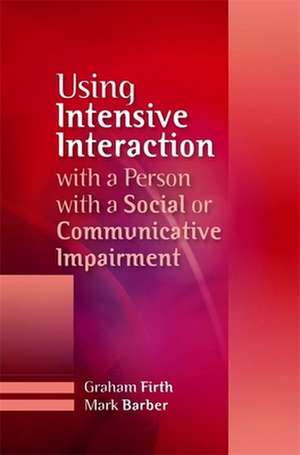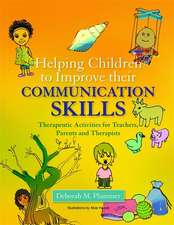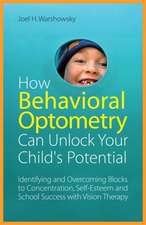Using Intensive Interaction with a Person with a Social or Communicative Imairment
Autor Graham Firth, MARK BARBERen Limba Engleză Paperback – 30 sep 2010
Preț: 144.92 lei
Preț vechi: 177.02 lei
-18% Nou
Puncte Express: 217
Preț estimativ în valută:
27.73€ • 30.11$ • 23.30£
27.73€ • 30.11$ • 23.30£
Carte disponibilă
Livrare economică 01-15 aprilie
Preluare comenzi: 021 569.72.76
Specificații
ISBN-13: 9781849051095
ISBN-10: 1849051097
Pagini: 160
Dimensiuni: 154 x 232 x 10 mm
Greutate: 0.25 kg
Editura: Jessica Kingsley Publishers Ltd
Locul publicării:United Kingdom
ISBN-10: 1849051097
Pagini: 160
Dimensiuni: 154 x 232 x 10 mm
Greutate: 0.25 kg
Editura: Jessica Kingsley Publishers Ltd
Locul publicării:United Kingdom
Notă biografică
Graham Firth is the current Intensive Interaction Project Leader for the Leeds Partnerships NHS Trust, UK. He was previously a further education teacher for adults with severe or profound learning disabilities. Mark Barber coordinates Intensive Interaction at Bayside Special Developmental School in Melbourne, Australia. He also works as a Consultant in Profound Intellectual Disability and Severe Communication Impairment in Australia and New Zealand.
Cuprins
Preface. Introduction. What is Intensive Interaction? Who might benefit from Intensive Interaction? Why should you be considering using Intensive Interaction? Who else may you need to talk to about using Intensive Interaction? Chapter 1. What to Do and Think About Before Using Intensive Interaction. Where are you going to try to use Intensive Interaction - is this the best place? What kind of observation have you done with the person - is it enough? What are you going to try to achieve in the first few minutes? What are you hoping to achieve in the whole session? Is this the best time to try and start - does it have to be now? How long have you got - is it going to be long enough? Do you have any necessary resource items available? Chapter 2. What to Do and Think About Whilst Using Intensive Interaction. What can you do to engage someone - what techniques can you use? Thinking back to your observations - what have you learned, and what should you be looking for now? How do you know if the person is ready for Intensive Interaction? Is this the best time to try and start - does it have to be now? How do you approach the person - what do you do first? What should you be looking for as you go along? Do you always have to follow the other person's lead, or are there times when you can lead the activity in some way? Have you achieved what you hoped for so far - what responses have you had, and were these what you were expecting or not? Are you still being sufficiently observant of the person? This particular activity has been going on for quite a long time - should you change what you are doing or just keep going? What are you hoping to achieve in the whole session? How much direct mirroring should you be doing - and how creative can you be with this? What if the person gets bored of repeated routines - how would you recognise this and what could you do about it? Can you try something a little different to see how the person responds - if so, when and how, and what should it be? Do you still have the necessary resource items available? How will you know if you have achieved something worthwhile? How long have you got left - is it going to be long enough? How do you disengage with the person if it is going well and they really want to continue? Should Intensive Interaction be this easy or this hard? Chapter 3. What to Do and Think About After Using Intensive Interaction. What did you do to engage the person - what techniques did you use and what have you learned from this session? How did you know if the person was ready for Intensive Interaction, and was this a good time to start a session? How did you approach the person - what did you do first, and how was this received? What new behaviours did you observe from the person during this session? Did you achieve what you hoped for, and was it worthwhile? Were you sufficiently observant of the person? Did they, or might they have done something you didn't see? Could you use some different resource items to better effect next time? Did you have long enough? How did you disengage with the person? What was easy or hard about the session? Chapter 4. Some Final Issues to Consider When Using Intensive Interaction. Consider what you can do to develop your own competence and confidence as an Intensive Interaction practitioner. Consider how other people can be productively involved and supported in developing successful Intensive Interaction. Consider how Intensive Interaction can be used in the longer term, and how this issue is best addressed and organised. Chapter 5. What You Might Expect to Come From the Use of Intensive Interaction. Further Reading. Glossary. Appendix. References. Index.












